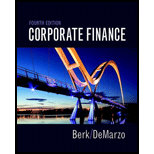
a)
To determine: Whether the following project has similar risk to that of average risk of the firm.
Introduction:
Risk includes the chance an investment’s real return will vary from the expected return. Risk includes the probability of losing all the original investment or losing some. Risk can be classified into unsystematic risk or systematic risk.
a)
Explanation of Solution
Given information:
Company C considers initiation of a new version of Armour, all designed to protect notebook computers and to clean.
Explanation:
Though there might be few differences, the market risk of the cash flows from this new products is expected to be similar to Clorox’s other household products. Thus, it is reasonable to accept that it has the similar risk similar to the average risk of the firm.
b)
To determine: Whether the following project has a similar risk to that of the average risk of the firm.
Introduction:
Risk includes the chance an investment’s real return will vary from the expected return. Risk includes the probability of losing all the original investment or losing some. Risk can be classified into unsystematic risk or systematic risk.
b)
Explanation of Solution
Given information:
Company G plans to expand its headquarters by purchasing real estate.
Explanation:
A real estate investment has different market risks compared to Company G investment in advertising and internet search technology. It is not right to assume this investment has risk equal to the average risk of the firm.
c)
To determine: Whether the following project has a similar risk to that of the average risk of the firm.
Introduction:
Risk includes the chance an investment’s real return will vary from the expected return. Risk includes the probability of losing all the original investment or losing some. Risk can be classified into unsystematic risk or systematic risk.
c)
Explanation of Solution
Given information:
Company T decides to enlarge the number of stores in the south eastern Country U.
Explanation:
Company T expands its business in the same line, which is likely to have the risk similar to the average risk of the firm.
d)
To determine: Whether the following project has a similar risk to that of the average risk of the firm.
Introduction:
Risk includes the chance that an investment’s real return will vary from the expected return. Risk includes the probability of losing all the original investment or losing some. Risk can be classified into unsystematic risk or systematic risk.
d)
Explanation of Solution
Given information:
Company GE decides to open a new U studio theme park in Country C.
Explanation:
The theme park is expected be sensitive in the development of the Country C economy. Its risk might be different from Company GE’s other divisions and from the company as a whole. It is not right to assume this investment had risk similar to the average risk of the firm.
Want to see more full solutions like this?
Chapter 18 Solutions
Corporate Finance (4th Edition) (Pearson Series in Finance) - Standalone book
- Dont use chatgpt! Which of the following is a characteristic of common stock?A) Fixed dividendsB) Voting rightsC) Priority in liquidationD) Guaranteed return on investmentarrow_forwardHello tutor i need help! Diversification in investing helps to:A. Eliminate all riskB. Increase potential lossesC. Reduce unsystematic riskD. Increase taxesarrow_forwardI need answer!! Diversification in investing helps to:A. Eliminate all riskB. Increase potential lossesC. Reduce unsystematic riskD. Increase taxesarrow_forward
- Diversification in investing helps to:A. Eliminate all riskB. Increase potential lossesC. Reduce unsystematic riskD. Increase taxesarrow_forwardI need help! Which market is used for trading newly issued securities?A. Secondary marketB. Money marketC. Primary marketD. Derivatives marketarrow_forwardWhich market is used for trading newly issued securities?A. Secondary marketB. Money marketC. Primary marketD. Derivatives marketarrow_forward
- I need answer! A higher beta in a stock indicates:A. Lower volatilityB. Higher volatilityC. No riskD. Stable returnarrow_forwardA higher beta in a stock indicates:A. Lower volatilityB. Higher volatilityC. No riskD. Stable returnarrow_forwardNeed help!! The time value of money concept is based on the idea that:A. Money loses value over timeB. Money today is worth more than the same amount in the futureC. Inflation doesn't impact moneyD. Currency values never changearrow_forward
- The time value of money concept is based on the idea that:A. Money loses value over timeB. Money today is worth more than the same amount in the futureC. Inflation doesn't impact moneyD. Currency values never changearrow_forwardDiversification in investing helps to:A. Eliminate all riskB. Increase potential lossesC. Reduce unsystematic riskD. Increase taxesarrow_forwardNo Ai!!! Diversification in investing helps to:A. Eliminate all riskB. Increase potential lossesC. Reduce unsystematic riskD. Increase taxesarrow_forward
 Essentials of Business Analytics (MindTap Course ...StatisticsISBN:9781305627734Author:Jeffrey D. Camm, James J. Cochran, Michael J. Fry, Jeffrey W. Ohlmann, David R. AndersonPublisher:Cengage Learning
Essentials of Business Analytics (MindTap Course ...StatisticsISBN:9781305627734Author:Jeffrey D. Camm, James J. Cochran, Michael J. Fry, Jeffrey W. Ohlmann, David R. AndersonPublisher:Cengage Learning EBK CONTEMPORARY FINANCIAL MANAGEMENTFinanceISBN:9781337514835Author:MOYERPublisher:CENGAGE LEARNING - CONSIGNMENT
EBK CONTEMPORARY FINANCIAL MANAGEMENTFinanceISBN:9781337514835Author:MOYERPublisher:CENGAGE LEARNING - CONSIGNMENT- Principles of Accounting Volume 2AccountingISBN:9781947172609Author:OpenStaxPublisher:OpenStax College



